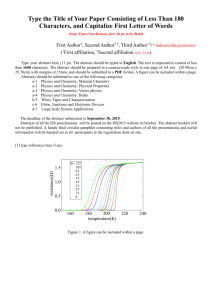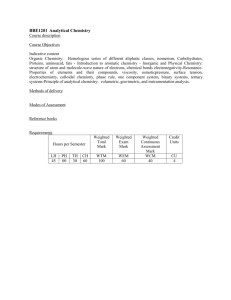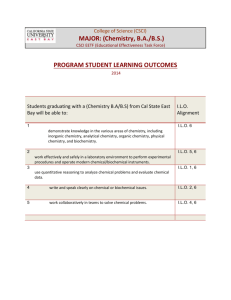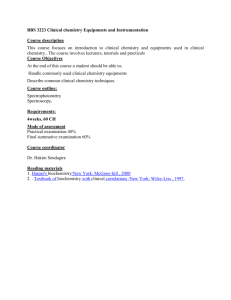Preparation for 2005 Advanced Level Chemistry
advertisement
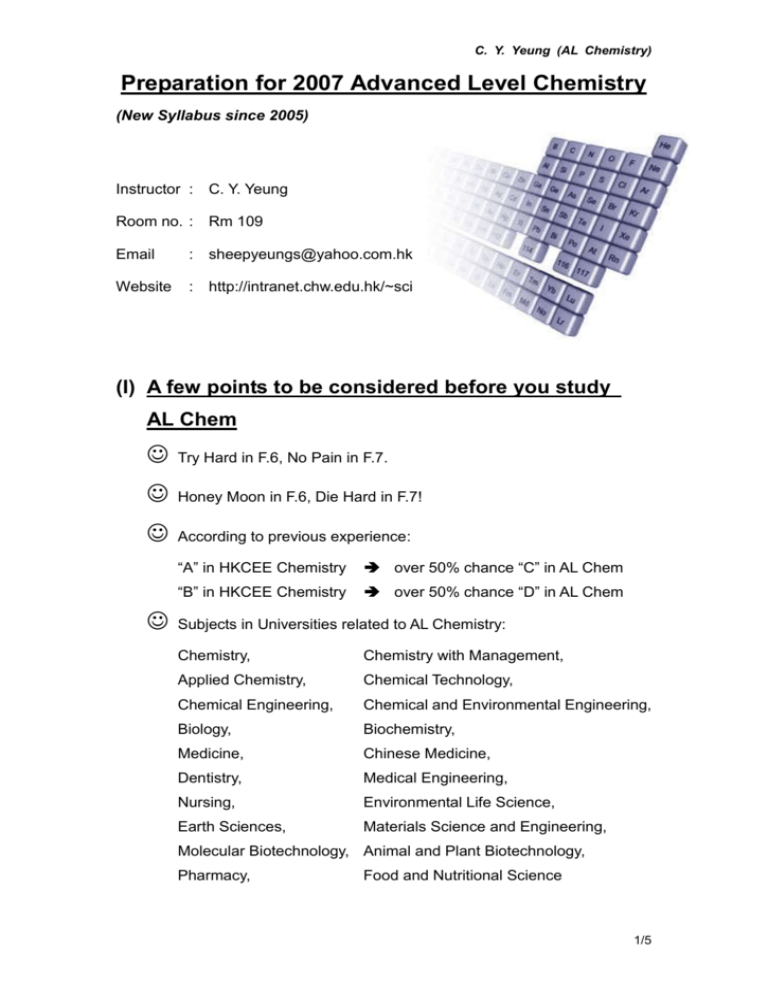
C. Y. Yeung (AL Chemistry) Preparation for 2007 Advanced Level Chemistry (New Syllabus since 2005) Instructor : C. Y. Yeung Room no. : Rm 109 Email : sheepyeungs@yahoo.com.hk Website : http://intranet.chw.edu.hk/~sci (I) A few points to be considered before you study AL Chem Try Hard in F.6, No Pain in F.7. Honey Moon in F.6, Die Hard in F.7! According to previous experience: “A” in HKCEE Chemistry over 50% chance “C” in AL Chem “B” in HKCEE Chemistry over 50% chance “D” in AL Chem Subjects in Universities related to AL Chemistry: Chemistry, Chemistry with Management, Applied Chemistry, Chemical Technology, Chemical Engineering, Chemical and Environmental Engineering, Biology, Biochemistry, Medicine, Chinese Medicine, Dentistry, Medical Engineering, Nursing, Environmental Life Science, Earth Sciences, Materials Science and Engineering, Molecular Biotechnology, Animal and Plant Biotechnology, Pharmacy, Food and Nutritional Science 1/5 C. Y. Yeung (AL Chemistry) (II) HKALE (Hong Kong Advanced Level Examination) Paper I (3 hours, 40% of Subject Mark) Section A --- (Compulsory): Short structured questions, 60% of Paper I, 24% of Subject Mark Section B --- (Compulsory): Short structured questions on practical chemistry, “written practical” 20% of Paper I, 8% of Subject Mark Section C ---- (Choose 1 out of 2 questions): Essay questions, 20% of Paper I, 8% of Subject Mark *** Starting from 2002, “comprehension questions” will be included in Paper IA (&/or Paper IB), usually on the application of chemistry and laboratory experiment. The information included in these comprehension questions may be quite strange to most AL students. Paper II (3 hours, 40% of Subject Mark) Section A --- (Choose 3 out of 4 questions): Long questions, 60% of Paper II, 24% of Subject Mark, Mainly Section 1 to 10 of the AL Syllabus (Physical Chemistry & Inorganic Chemistry) Section B --- (Choose 2 out of 3 questions): Long questions, 40% of Paper II, 16% of Subject Mark, Mainly Section 11 to 13 of the AL Syllabus (Organic Chemistry & Chemistry and Society) Paper III Practical Exam (TAS, 20% of Subject Mark) Mr. Yeung will mark your lab report and give back your report after the experiment, and tell you the mistake you had made. Both the experimental technique, attitude and experimental results will be assessed in the scheme. 2/5 C. Y. Yeung (AL Chemistry) (III) Course Outline and Syllabus of A-Level Chemistry Approx. % Physical Section Contents 1 Atoms, Molecules and Stoichiometry 2 The Electronic Structure of Atoms and the Periodic Table Chemistry 3 Energetics (45%) 4 Bonding and Structure 5 Chemical Kinetics 6 Chemical Equilibrium 7 Inorganic Periodic Properties of the Elements in the Periodic Table Chemistry 8 The s-Block Elements (15%) 9 The p-Block Elements 10 The d-Block Elements 11 Fundamentals of Organic Chemistry 12 Chemistry of the Organic Compounds 13 Polymers, Drugs and Green Chemistry Organic Chemistry (25%) Chemistry in Action (15%) 3/5 C. Y. Yeung (AL Chemistry) (IV) The Laboratory Practical Section You must read the lab. Manual before the day of experiment (“pre-lab”). You have to gather relevant information concerning the experiment from various resources such as reference books and internets. In the 1st and 2nd months, the experiments are mainly titrations in Section 1 of the AL Chem syllabus. You have to concentrate on the writing all the lab. reports, especially in the parts of “DISCUSSION” and “ANSWERS TO QUESTIONS”, as most of them will be marked in the TAS. How to write a “GOOD REPORT” for TAS? A good “long lab report” usually includes the following parts: Title: e.g. Objective: e.g. Determination of the molar mass of propanone To measure the volume and mass of the vapour formed from propanone and use these values to determine the molar mass of propanone by Ideal Gas Equation Theory: should include the equations, laws and assumptions concerned in the experiment. Apparatus: e.g. 250cm3 syringe, thermometer, test tubes, etc. You may also draw a diagram to show the apparatus. Procedure: the actual procedure you have done in the lab. lesson. Result and Calculation : DON’T FORGET to get all the relevant data, e.g. pressure, temperature, etc. Discussion: e.g. interpretation of data, explanation on observations, the difficulties encountered, sources of errors, suggestion for the improvement of procedure, 4/5 C. Y. Yeung (AL Chemistry) Answers to Questions: you have to search answers from many reference books and external sources. Conclusion: e.g. The molar mass of liquid X is 78 g mol-1. ### More marks will be given to lab reports with excellent “Interpretation of Data”, “Explanation on Observations”, “Calculation” and “Discussion”. (V) Further Suggestion on Studying AL Chemistry For a typical student who got a “C” in HKCEE Chemistry wants to get a “C” in AL Chemistry, the following time allocation is strongly recommended: Approx. no. of hrs / week *** Revision on materials covered in lectures 6 Do suitable exercises 4 “Pre lab.” preparation of laboratory experiment 1 Writing lab. report 3 Total 14 hours What to do Textbook and Reference Books 1. New Way Chemistry for Hong Kong A-Level [Manhattan] (Textbook) 2. Comprehensive Chemistry “HKAL” course (Physical Chemistry I, II; Inorganic Chemistry, Organic Chemistry, Chemistry and Society) [Fillans] 3. Chemistry --- the Central Science [Brown, LeMay, Bursten (Prentice Hall)] 4. Chemistry [Raymond Chang (McGraw-Hill)] 5. Chemistry for Changing Times [John W. Hill, Doris K. Kolb (Prentice Hall)] 6. A-Level Chemistry [Stanley Thornes] ### The HKALE past paper questions are strongly recommended as exercises. It is not necessary to buy many extra exercise books in AL chemistry because you do not have enough time to finish them. However, you are reminded that many questions before 1988 are extremely difficult for you to practice. ~ The End ~ 5/5



